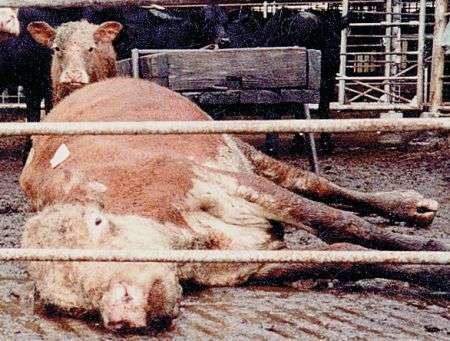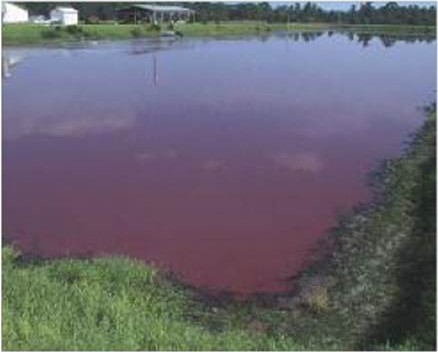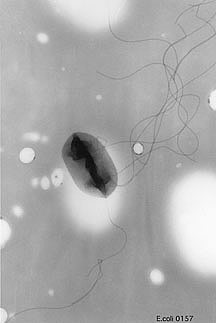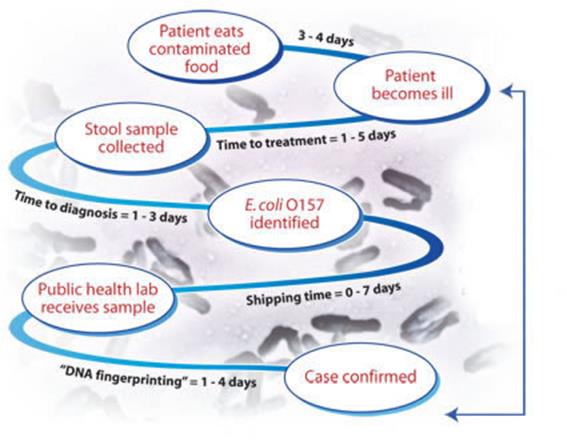
Industrial Livestock Production
Livestock farming, raising animals as a source of food for people, has undergone a substantial transformation over the past few decades. Production of cattle, hogs, and chickens has shifted from smaller, family-owned farms to large-scale industrial agricultural facilities often known as concentrated animal feeding operations (CAFOs). As part of that shift, cattle no longer graze on pastures, but instead eat grain. Their stomachs are not designed to handle such a diet and this has led to the emergence of E. coli O157:H7, a bacteria that has serious consequences for human health. Also of great importance to human health is the issue of antibiotic resistance. As cattle operations moved from smaller farms to CAFOs, animals became more crowded and more susceptible to disease. Therapeutic use of antibiotics led to the discovery that animals on constant low doses antibiotics grew larger faster. As farms continue to grow and antibiotic use increases, the emergence of resistant organisms must be addressed. A frequently unconsidered part of CAFOs is the enormous amount of waste produced. Management if the manure is a complex issue that has no easy answers and has the potential to contaminate the surrounding environment. Modern livestock production is hardly recognizable from what it was even 50 years ago and the issues and problems have grown along with it.
While modern agricultural methods may produce economical benefits for the supplier and consumer, the scale of foodborne transmission is an increasing public health concern, and new hazards are being recognized.
After successfully completing this module, students will be able to:
The USDA reports that since 1960, milk production has doubled, meat production has tripled, and the United States has become the largest fed-cattle industry and producer of beef in the world. Below is an interactive map of U.S. meat consumption in 2011 by state. \\Include sentence with instruction on how to interact with map\\
From 2002 to 2007, the landscape of cattle farms in the United States has changed. Of farms that raise cattle for beef, CAFOs that raise between 200 and greater than 2,500 cattle have increased. CAFOs with greater than 2,500 cattle have increased 17% and CAFOs that raise between 500 and 2,499 have increased 10%. In contrast, smaller operations have declined by 7% on average.
Food and Water Watch, an advocacy group that works to ensure the food, water and fish people consume is safe, accessible and sustainably produced, has produced a factory farm map to visualize the concentration of CAFOs. When using the map, you may sort by type of animal raised and/ or state.
The effect of these CAFOs on human health is yet to be fully determined, but studies have shown an association between negative respiratory outcomes in CAFO workers. Studies have also been undertaken to determine if levels of hydrogen sulfide - from the breakdown of animal waste, ammonia - also from the breakdown of animal waste, and organic dust - from grain and bedding - are elevated in and around homes in close proximity to CAFOs. All three of these substances cause respiratory irritation in humans, and are heightened in those with asthma. Exposure to high levels of hydrogen sulfide is fatal.
Additionally, overcrowding leads to animals standing and laying in their own waste, allowing the ready spread of pathogens and requiring the use of antibiotics to keep animals healthy which, in turn, aids antibiotic resistance in common bacteria. Hides covered in manure can also contaminate the slaughterhouse, where the push to process animals faster leads to shoddy hygiene, and can result in massive and deadly outbreaks of bacteria such as E. coli 0157:H7.
The origin of moving from pasture fed cattle to grain fed cattle is closely tied to the industrialization of farming. Small family owned & operating farms have been almost entirely replaced by large scale industrial farming operations.These operations have resulted in high rates of food production, which originate from moving to a model of raising animals in confinement, and feeding animals feed that are formulated to increase growth rates and feed conversion efficiencies. While the number of beef cow operations in the United States has fallen by almost a quarter of a million since 1986, the number of beef cows has remained constant at about 33 million (Agri 101).
Post World War II there was were a large and rapid number of technical advancements which led farms from using animal power to harvest crops to relying on machines which produce crops quickly and at a smaller cost (Dimitri). Research on the effects of feeding cattle corn, for the purpose of fattening steers, was first released in the 1950s (Corah), which corresponds with the movement to industrialization. Industrial farming also introduced growth hormones and feed additives to improve the production of meat (Cite this article).
The diet of cattle typically consists of grass eaten while foraging, although cattle raised for meat that are typically fattened in feedlots are fed a diet supplement with grains in order to increase the density of their diet.
The debate between feeding cattle a diet primarily composed of grass or a diet primarily composed of grain, corn, and other supplements is complicated. Scientists, industrial farmers, environmentalists, and the like approach the debate differently, and have different priorities in mind. While traditionally a farmer's productivity was inextricably linked to the welfare of the animals, modern industrial farming is no longer driven by the farmer's need to survive and sustain a livelihood. Instead, farming is driven by economic incentives, pushing farms to produce food more cheaply to increase profits. While there are economic and environmental pros and cons to feeding cattle grass versus grain, the following sections will focus on the scientific research done concerning the digestion of cattle, and the effects grain feeding has on acid resistant e Coli.


Beef is a significant source of protein in the American diet, with the average person consuming nearly 70 lbs of beef each year (Argi 101). The quality of the beef is directly related to animal feeding practices (Sapkota). The ingredients fed to the cows both affect quality of the meat products and the potential health impacts on both the cows and humans (Sapkota).
The beef industry in the US provides more than one million jobs. In addition, for every dollar of cattle sales, there is an about five dollars in additional business activity generated (Argi 101). The industry is clearly a large economic driver, and feeding animals grain helps cattle grow bigger faster. But what does this mean for the people/animals? What are the consequences of feeding cattle grain rather than grass?
Unlike most animals with a basic one-compartment stomach, cattle have four distinct chambers of their stomach—the reticulum, the rumen, the omasum, and the abomasum. Animals with this type of digestive system are called ruminants. The video below provides a brief overview of the cow's digestive system.
There are some digestive issues of concern that can arise from the type of food cattle consume. Bloat is a common digestive disorder in beef cattle. While it most often occurs in feedlot cattle, it can also affect cattle consuming too much fresh grasses. Bloat results when cattle are prevented from eructating or belching, which helps release gases produced normally from microbial fermentation. Gas production may then exceed gas elimination causing pressure on the diaphragm and lungs. This compression can reduce or even cut off the animal's oxygen supply and result in death by suffocation.
Acidosis is another digestive issue that can arise when cattle are shifted from a forage-based diet to a high-grain diet. The chemical balance that facilitates fermentation in the rumen is greatly affected by the diet of the cow. A sudden change in diet, for example from mostly hay to mostly grain, can result in a rapid increase in acidity in the rumen. Acidosis can damage the lining of the rumen causing digestive disruption and dehydration.
The USDA produces a semi-annual "Cattle on Feed Report" available that highlights the number of animals being fed grain throughout the United States.
Acid-Resistant E. coli
Cattle are natural reservoirs for pathogenic E. coli, and cattle fed mostly grain have been shown to have lower colonic pH, meaning they are more acidic, thus creating an ideal environment for increased numbers of acid-resistant E. coli compared to cattle fed only hay. This is because the gastrointestinal tract of a cow digests starch poorly, therefore some under-digested grain arrives at the colon where it is fermented. The acidity and the acids accumulated in the colon are largely responsible for the production of acid-resistant E. coli.
\\ Needs to be a break in the paragraphs with some interactivity/graphic here..or a different way to present content below so it doesn't seem as paragraph-dense \\
Research shows that grain-based cattle diets promote the growth of E. Coli, and such contamination is responsible for as many as 20,00 infections and 200 deaths each year, within the United States. Studies have found that cattle fed grain-based rations similar to those of CAFOs had 1 million acid-resistant E. coli, per gram of feces. By comparison, cattle fed hay or grass had only acid-sensitive E. coli, and these bacteria were destroyed by an "acid shock" similar to that of the human stomach.
The human stomach acts as a barrier to food-borne pathogens, but acid-resistant E. coli is able to withstand stomach acid and cause illness. To decrease instance of E. coli in humans, focus must be placed on decreasing the occurrence of acid-resistant E. coli, such as that which is found within cattle. Research has found that a brief period of hay feeding, as little as five days, reduces the number of acid-resistant E. coli in cattle to similar levels as if the cattle had been fed an all-grass diet their entire life. While in current industrial farming it is unrealistic to 100% switch cattle from grain back to grass diets, this research provides a relatively easy alternative. Additionally, studies indicate that the risk of food-borne E. coli infection is significantly decreased when cattle are given hay in the brief period before they are slaughtered.
The following clip from Food Inc. provides a brief overview of the issue of acid-resistant E. coli.
In agriculture, antibiotics are used for veterinary medicine, additives for food, and biocides. Although antibiotics were originally used to treat livestock that have specific diseases, the vast majority of them are now used in industrial food animal production (IFAP) to prevent infections from various pathogens that infect the livestock due to their close living quarters, lack of clean living spaces, and weakened immune systems from lack of exercise and nutrition. This leads cattle to contract diseases The antibiotics also help animals grow larger to provide more meat. In low doses, antibiotics can help animals grow larger, but the biological mechanism for why this occurs is still unknown. These heavier animals produce a greater quantity of meat and thus generate higher profits.
The use of antibiotics in factory farming is on a greater scale than any other use of antimicrobials around the world, and most major classes of antibiotics are being used this way. Approximately 80% of antibiotics consumed in the United States go to factory farms. Antibiotic resistance is growing rapidly and weakens the efficacy of medicine. Staphylococcus aureus (MRSA), H1N1 flu strains, and Plasmodium falciparum (malaria) have changed and are growing immune to more antibiotics at a rapid rate (Antimicrobial Resistance, CDC).
IFAP breeds dangerous pathogens due to the dense confinement of high quantities of animals and the distribution of CAFO. This wide-scale enclosure of zoonotic diseases, or zoonosis in small spaces increases the magnitude of disease transfer, especially because the confined livestock are repeatedly exposed to their own waste and that of the animals around them as shown in the image below.

The excessive use of antibiotics is concerning because the antibiotics which animals receive are not regulated or recorded. When antibiotics are administered to large quantities of healthy animals, the bacteria is more likely to mutate and develop resistance simply because it is being distributed in large quantities. Antimicrobial-resistant bacterial infections spread many emerging infectious diseases, such as E. coli O157:H7. Random mutations in bacteria can change their genome, causing them to become resistant to antibiotics but still cause illness. For example, random mutations can create bacteria with altered cell walls that medicine can't bind to or enzymes that render antibiotics inactive. In the IFAP system, livestock routinely receive the same antibiotics that humans use as medication, so when humans consume meat with resistant bacteria and they colonize within the human body, the antibiotics people take against them fail to have an effect. As a result, many antibiotics are rapidly growing ineffective due to the expansion of factory farming.
The following video clip shows a news special demonstrating the creation of drug resistant bacteria due to over distribution of antibiotics in livestock.
Because farmers are giving healthy animals such high doses of antibiotics, antibiotic resistant bacteria develop in their intestines. Furthermore, antibiotic-resistant bacteria remain in the feces of animals and can contaminate crops when they are used as fertilizer. When produce and other farm products fall or aren't handled in a sanitary way, they can become contaminated with these bacteria particles as well. When not handled carefully or washed away thoroughly, these remain on food products and are consumed by humans, who become sick. The cycle can grow even more vicious when people take incorrectly diagnosed antibiotics with the belief that it will heal them faster, creating additional resistance in other bacteria.
Overuse of antibiotics in livestock has led the greater antibiotic resistance, leaving a lack of options for those in need of antibiotics for treatment. The photo album activity below illustrates some of the consequences of antibiotic resistance.
The most pressing public health issue associated with CAFOs stems from the amount of manure they produce. The amount of manure production can range anywhere between 2,800 tons and 1.6 million tons per year. To put this into perspective, this amount of manure can exceed the amount of human waste output of U.S. cities. In fact, the Office of Government Accountability estimates that livestock animals in the U.S. produce somewhere between 3 and 20 times more manure than people in the U.S. produce each year as a whole. Unfortunately, livestock manure treatment plants do not exist. With such an overflow of manure, livestock are left standing ankle deep in their own waste as show in the image below. This, in turn, allows for manure to accumulate all over the animal's body, which presents a breeding ground for deadly pathogens such as Escherichia coli 0157:H7 to multiply and spread into the food and water system.
The biggest challenge to manure management is keeping up with the overwhelming volume of manure being produced. The careful management and removal of this amount of waste is crucial to public health and preserving the environment. Unfortunately the current manure management methods are having a difficult time keeping up.
|
Current Manure Management Strategies |
Key Limitations |
|
|
Below is a guide developed by the National Association of Local Boards of Health developed to provide more information about CAFOs and their impact on communities.
 Huge lagoons of stored liquid manure can frequently spill into nearby groundwater sources, as well as contaminate fields of commercially raised vegetables and orchards during heavy rain. This produces not only a serious threat to drinking water, but also results in produce-associated contamination.
Huge lagoons of stored liquid manure can frequently spill into nearby groundwater sources, as well as contaminate fields of commercially raised vegetables and orchards during heavy rain. This produces not only a serious threat to drinking water, but also results in produce-associated contamination.
Pathogens have the ability to survive longer in groundwater than surface water due to lower temperatures and protection from the sun, and thus can become attached to sediment and become a lingering source of contamination for groundwater. Manure run off from leaks and overflow is a major concern to public health officials, and is one of the main sources of E.coli contamination in drinking water. The image (right) shows liquid manure being stored in an open-air reservoir, a common storage method for CAFOs.
Provided below is an audio interview by Dr. Dennis Maki, an epidemiologist and professor of medicine at the University of Wisconsin School of Medicine and Public Health. Dr. Dennis Maki explains how manure run off is resulting in contamination of E.coli in meat, vegetation, and groundwater. He suggests necessary steps to take in order to mitigate outbreaks of E. coli.
Most strains of E. coli, which are motile, rod-shaped bacteria, are harmless bacteria and are part of healthy flora that live in the intestines of healthy humans and animals, but there are some pathogenic strains that cause disease. Pathogenic E. coli strains are categorized into pathotypes. There are five main pathogenic serotypes: O26:H11, O103:H2, O111:H8, O145:H28, and O157:H7. These pathogenic serotypes produce a powerful Shiga toxin, also known as a verotoxin,that cause disease in humans. E. coli 0157:H7 has become the most well known and reported of these pathogenic strains found in the manure of cattle.
E. coli O157:H7 was first recognized as a cause of illness in 1982 during an investigation into an outbreak of hemorrhagic colitis associated with consumption of hamburgers from a fast food chain. \\ Provide some more info on this investigation \\
Although most infections are believed to stem come from eating undercooked ground beef, E. coli 0157:H7 contamination can be found in things such as meats, raw milk products, unpasteurized apple cider, produce, and contaminated water.
According to a study in 2007 from the Department of Animal Biotechnology at the University of Nevada Reno, over the past thirty years, there has been an increase in "the prevalence rates of E. coli O157 infection worldwide. "The prevalence rate ranged from 0.1 to 54.2% in ground beef, from 0.1 to 4.4% in sausage, from 1.1 to 36.0% in various retail cuts, and from 0.01 to 43.4% in whole carcasses….With regard to beef cattle, the prevalence rates of E. coli O157 ranged from 0.3 to 19.7% in feedlots and from 0.7 to 27.3% on pasture."
The results of this global assessment of the beef cattle role in human infection with Shiga Toxin producing E.coli emphasizes the critical need for more control measures to assure beef safety. Access to the full article is available below.
The CDC estimates there are approximately 169,600 E.coli O157:H7 infections each year in the United States. Public health experts can only rely on estimates rather than actual numbers of infections because not all infections are diagnosed; many infected people do not seek medical care; many of those who do seek care do not provide a stool specimen for testing. Because many people do not report infection with E.coli, the CDC estimates that for every E. coli 0157:H7 case reported, there are 26 cases not diagnosed.
 Japanese researchers at the Research Institute for Microbial Diseases studied the attachment mechanism for E. coli in 2001. The following steps describe the process.
Japanese researchers at the Research Institute for Microbial Diseases studied the attachment mechanism for E. coli in 2001. The following steps describe the process.
This video gives a great visual explanation for the ways in which E.coli invade intestinal cells:
Cattle are reservoirs for Shiga toxin producing E. coli bacteria. E. coli 0157:H7 strains do not make cattle sick because their bodies do not have receptors like humans do for the toxin to attach and replicate. Meat typically becomes contaminated with E. coli during the slaughtering process, when the contents of an animal's intestines and feces are allowed to come into contact with the carcass. Unless the carcass is properly sanitized, the E. coli bacteria are mixed into the meat as it is ground. As much as 2 to 3% percent of domestic cattle carry E. coli 0157 at the time of slaughter.
Shiga toxin-producing E. coli is spread to humans when contamination occurs in food and water. Humans can also become infected if they are directly exposed to livestock on farms or petting zoos. Infection can spread from person to person if proper sanitation methods are not met. Although most reported infections with Shiga toxin-producing E. coli are linked to undercooked ground beef, nearly 25% of outbreaks come from commercial fruit and produce.
The following video clip from the 2008 documentary, Food, Inc. demonstrates the methods for pathogens to spread from cattle to humans during the slaughter process.
Although a person of any age can become ill from Shiga Toxin-producing E.coli, very young children and the elderly are the most susceptible to developing severe illness. The symptoms of Shiga Toxin E.coli infection can vary from person to person, but the following symptoms are most common:
\\ Break from paragraphs...little dense in text in paragraphs below...possible abbreviate with some sort of interactivity \\
Symptoms usually appear within 3 to 4 days, but can take up to 8 days to fully recover. Most people recover without antibiotics or other specific treatment in 5-10 days. Hydration is very important in recovery. According to the CDC, approximately 2%-7% of infections lead to hemolytic uremic syndrome, a complication that can lead to acute kidney failure from the abnormal premature destruction of red blood cells. In the United States, hemolytic uremic syndrome is the principal cause of acute kidney failure in children. The death rate for hemolytic uremic syndrome is 3%-5% with intensive care; however, timely and appropriate treatments usually lead to a full recovery for most people. E. coli infection is usually confirmed by the detection of the bacteria in a stool specimen from an infected individual.
E.coli 0157:H7 is a reportable disease both nationally and on a state level. The below graphic demonstrates the timeline between when a person eats contaminated food and when a case is confirmed. The graphic illustrates the series of events that takes plae between the time a person is infected and the time public health officials can determine that the person is part of an outbreak. Public health officials work hard to minimize the gap between when a person gets sick and when that person is confirmed to be part of an outbreak although some delay is inevitable.

Outbreaks of E.coli 0157:H7 continue to happen each year. For the past two years in a row, produce has been the main source of contamination. The most recent E. coli O157:H7 outbreak reported by the CDC as of November 19th was due to a contamination of ready-to-eat-salads. Thirty two people reported infection in four states: Arizona, California, Texas, and Washington; seven were hospitalized. In 2012, an outbreak of E.coli 0157:H7 from organic spinach and spring mix blend led to thirty three infections and thirteen hospitalizations in five states.
For a detailed look at all outbreaks since 2006, visit the CDC's website, Reports of Selected E. coli Outbreak Investigations.
Illness due to contaminated food is a widespread health problem. Preventing the spread of E.coli infection requires control measures at all stages of the food chain, from agricultural production on the farm, to the preparation of foods in both commercial establishments and at home. Hygienic education is an essential step to keeping the spread of E.coli to a minimum.
 \\This needs a paragraph blurb to talk about the importance of personal hygiene and food safety measures before going into the specific list of measures below. Food safety regs for food establishments might be worth mentioning.\\
\\This needs a paragraph blurb to talk about the importance of personal hygiene and food safety measures before going into the specific list of measures below. Food safety regs for food establishments might be worth mentioning.\\
To protect yourself and others against the spread of E.coli infection, the CDC recommends following these simple rules:
\\The module started by addressing farming practices as a culprit of health concerns...here would be a good place to conclude the module by bringing it back to the farming practices, which would be the ultimate preventive measure. The intro blurb talked about control measures at all stages of the food chain...i.e. HACCP?\\
\\ Need to organize this pageand incorporate some citations into sections throughout the module \\
\\ We can incorporate these questions below throughout the module by matching them to the page on which they are covered.\\
Quiz questions:
Jenny's questions:
Katie's Questions:
Natalie's Question:
Steve's Questions: